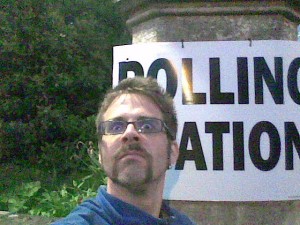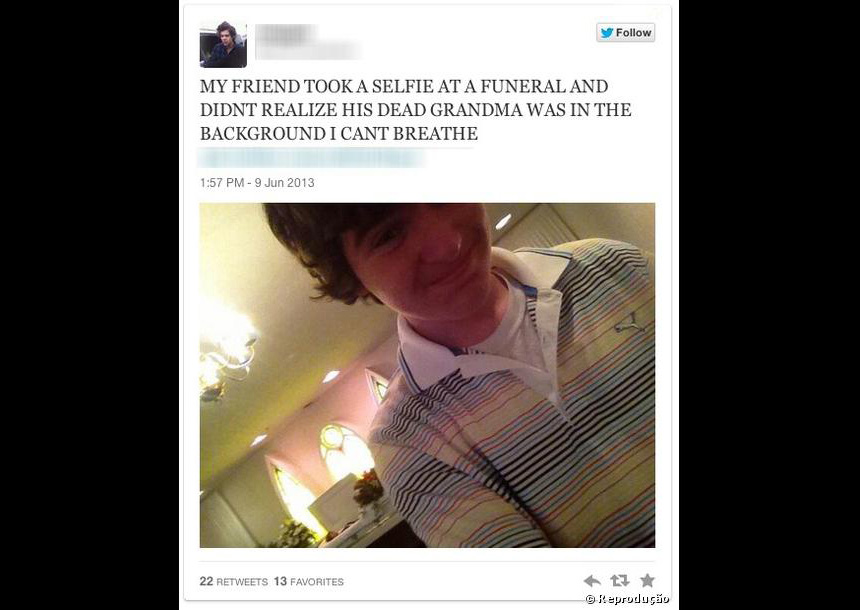Selfies at Funerals
Jason Feifer, @HeyFeifer
RT If You’re 🙁 About Someone Dying
Katy Waldman, Slate (November 1, 2013)
A Passionate Defense of Selfies at Funerals
Caitlin Doughty, Jezebel (October 30, 2013)
When Cameras Took Pictures of Ghosts
Megan Garberoct, The Atlantic (October 30, 2013)When photography was new, people used it to suggest the endurance of the departed.
Dark tourism: Why Murder Sites and Disaster Zones are Proving Popular
Will Coldwell, The Guardian (October 31, 2013)
Selfies at Serious Places
Jason Feifer, @HeyFeifer
Charlie Brooker’s Black Mirror
Series 2, Episode 1 Be Right Back (February 2013)
The kids today. They can’t catch a break.
I watched the Selfies at Funerals Tumblr link roll across the internet this week and after seeing the images I immediately knew what was going to happen. People would complain about how the kids today were so self-absorbed that civilisation was near its collapse and how today’s youth don’t have any respect. I also knew that after this immediate condemnation, another group of voices would rise up to support the forsaken youth.
And this, Death Ref faithful, is exactly what happened.
The kids in the Selfies were damned left and right. It got a little thick at times.
But then, as should always be expected, another group of people took a more nuanced stand per the Selfies.
My good friend Caitlin Doughty at the Order of the Good Death wrote a strong defense of the kids on Jezebel and I mostly agree with her thoughts on the images. Where I disagree with Cailin is in arguing that these images represent a broader social disengagement with the reality of death. If anything, these photos show young people engaging with death, and doing so with a specific language that they’ve developed.
We humans invented all of our human death rituals. As a result, this means that all death rituals are constantly being changed, altered, and turned into hybrids. There is nothing innate about any ritual (given its human construction) so I think that it’s important to say that I would be more surprised if young people weren’t taking Selfies at funerals. This is the world they know but that doesn’t mean that today’s youth somehow lack any education about death.
Ironically enough, the Selfies at Funerals Tumblr page probably caused thousands more people to discuss actual death and funerals this week because of its supposedly disrespectful tone. Maybe, just maybe, the kids beat the adults at their own ‘We NEED to talk about death game.’
Katy Waldman at Slate took a wise step and waited a few days before writing anything. She presents a good critique of responses to the images but also brings everything back to the kids using the photographs as forms of grieving. I agree with this point and I kept waiting for someone to roll out a broader discussion about the relationship between photography and death.
Photography has a long standing relationship with funerals, especially in America. The camera phone is only the most recent example of a technology we humans use to capture images at funerals. Another way of looking at these photos is this– what else would anyone in the First World expect teenagers to do with their camera phones at funerals? Megan Garberoct at The Atlantic wrote an uncannily timed article on 19th century postmortem photography and the ability of Victorian era photographers to capture ‘Sprit’ images with their cameras.

But more than the photos themselves, it seems that the people criticising the kids just don’t like the technology involved, i.e., the camera phone that produced the self-taken image.
Here, then, is the key lesson for everyone loving to hate and hating to love the Selfies at Funerals: We humans remain deeply conflicted when mixing all forms of technology with death.
The great science fiction writer Douglas Adams (who died far too young) made the following observation about humans and technology in The Salmon of Doubt:
I’ve come up with a set of rules that describe our reactions to technologies:
1. Anything that is in the world when you’re born is normal and ordinary and is just a natural part of the way the world works.
2. Anything that’s invented between when you’re fifteen and thirty-five is new and exciting and revolutionary and you can probably get a career in it.
3. Anything invented after you’re thirty-five is against the natural order of things.
Given that my own research in the University of Bath’s Centre for Death and Society examines how technology and death intermingle all the time, I want to let everyone know that Selfies at Funerals represent only the beginning of a much longer future. We should already be asking ourselves what happens when a person wearing a computing machine, such as Google Glass, captures images and video at a funeral. Is a line being crossed there and why? How? I ask these questions, because it is going to happen and happen soon.
Just remember, and not so long ago, the idea of using the internet for anything to do with death seemed inappropriate. So did playing pre-recorded music on a CD (especially loud rock and roll music), having mourners draw or paint on a coffin, or even choosing to be to cremated.
What we humans forget is that death’s persistence means that we will persistently invent new kinds of death rituals. No ritual lives forever. Will Coldwell’s Guardian article on Dark Tourism highlights how easily the very idea of established and appropriate ‘death rituals’ can be changed.
Earlier this year, Charlie Brooker’s Black Mirror television series ran an episode called Be Right Back that effectively dramatised how the not-to-distant future might offer new kinds of technology for human grieving. Here is the show’s description:
Martha and Ash are a young couple who move to a remote cottage. The day after the move, Ash is killed, returning the hire van. At the funeral, Martha’s friend Sarah tells her about a new service that lets people stay in touch with the deceased. By using all his past online communications and social media profiles, a new ‘Ash’ can be created. Martha is disgusted by the concept but then in a confused and lonely state she decides to talk to ‘him’…
Trust me when I say that if the technology imagined in Black Mirror suddenly appeared, the Selfies at Funerals shock and outrage would quickly wash away into the sea of human memory.
So where does this week take us? It’s hard to say, because I have a feeling most people have already forgotten about the Selfies at Funerals and moved on to other more pressing issues.
But I do think that it is now time to officially launch a new Death Reference Desk rule about death and technology. To wit:
The Death Ref Technology Law: Any use of new technology that involves death, dying, and/or the dead body will be simultaneously rejected as a breakdown in human civility as well as embraced as an innovative turn for human grieving.
Or, as my friend Max summed up the situation on Facebook:
I was disgusted by this until I remembered I took a selfie at the last funeral I went to. Now I’m okay with it.
